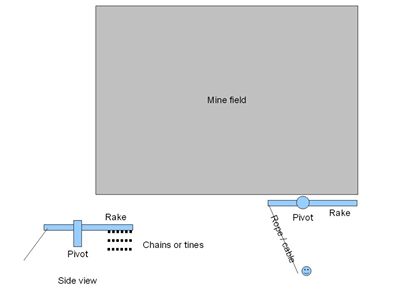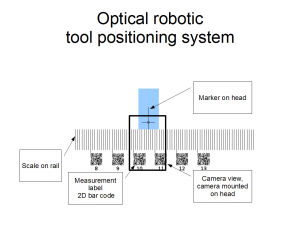Zero Mines, cheap-low-tech land mine clearing tool
Zero Mines is a group of people worldwide working on Open Source solutions for clearing land mines so people can grow food, travel, and live safely. Here is my suggestion.

Over 100 million land mines have been deployed around the world. Most of the places where these land mine are located are impoverished. The area that needs to be cleared is vast. The ideal solution would use cheap, easily available materials, that can be put together by anyone so that local people can quickly clear their own land.
The standard military approach to clearing a mine field is to use a heavily armored vehicle with a motorized flail to trigger the landmines. Armor is one way of staying safe while detonating a mine but not the only way. Distance is another.
A strong rope is cheap and can pull a heavy object across a mine field from a distance to detonate any mines. But you typically must go forward into a mine field. So how can you pull something towards you without first putting it in front of you? There is a very simple way.
The device I described fits those requirements. It is just a big rake rotating on a pivot pulled by a rope or cable from a safe distance to trigger mines.
1. place the pivot
2. pull the rope or cable from a safe distance or behind sand bags
3. sweep the rake over area to be cleared
4. move pivot / rake to cover more area
5. repeat
Dragging an object a distance from the arm would reduce the damage to the arm but even if the arm is damaged it is cheap and easy to replace. This might not be enough for all uses of the land or all types of land but can quickly clear an area for human travel and light use. If you need to go deeper use a heavier object and tines to dig up the ground.
Twitter distributes software 75 times faster using BitTorrent
![]() My business associate developed the BitTornado software Twitter is using to solve their server update problem. It’s the same type of problem Apple had when I worked there in 1992. The solution approach similar.
My business associate developed the BitTornado software Twitter is using to solve their server update problem. It’s the same type of problem Apple had when I worked there in 1992. The solution approach similar.
A single distribution server is a bottleneck both for efficiency and reliability. A single server slows down as more clients are accessing it. If the single server fails the entire process stops.
Predictive Innovation defines 15 Alternatives for any problem. The 15 Alternatives are arranged into two dimensions of 3 scales and 5 directions. The 3 scales are Single, Multiple and Continuous (see “Predicting the Next Disruptive Innovation” for more details).
When I was at Apple we solved the problem by moving from a Single mainframe to multiple servers and clients. This spread the bandwidth across more computers and provided more flexibility for doing ad-hoc reports.
BitTorrent is a Continuous solution. It doesn’t just spread the bandwidth over more computers, it spreads it over all the computers using the torrent. It produces the maximum bandwidth with the least vulnerability. It also flips the concept of speed on its head. Instead of getting slower as more computers download a file, it gets faster. Any computer connected to the torrent can share pieces with any other computer connected to the torrent. This is also how it reduces vulnerability. There are multiple sources for the pieces of the file, even if none of them have a complete copy of the file.
3D Printer / CNC head positioning ideas
Ideas to make high precision low cost head positioning systems for 3D printer / fabricators / CNC machines. Precision stepper motors are expensive. What if you could use cheap analog motor? They could be very fast and cheap.
Electrical Resistance
Run a length of wire along each axis of the printer / fabricator / CNC and measure the resistance at the head position. Using a table of actual resistance measurements on the device could increase accuracy and even heat differences could be taken into account. This could be extremely accurate and low cost.
Optical
Optical is another approach, this is how mechanical mice and mane printers function. Using a digital camera with distance measurements on a scale printed from a long format printer could make the device very fast and accurate. Using optics the accuracy could increased fine precision even with cheap webcam sensors.

RF Triangulation
Mounting an RF transmitter on the head and antennas at the corners of the tracks could allow triangulation of the head to extremely high precision even over very large distances. This is the same technique used by GPS and cell phone towers. The precisions scales with size and frequency transmitted.
Electrical Balancing
Using opposing electrical currents to create a balance for any location along the rail. With the correct calibration this can be very accurate plus provide very fast movement.



 Predictive Innovation Training
Predictive Innovation Training Predictive Innovation: Core Skills Book
Predictive Innovation: Core Skills Book RoundSquareTriangle.com
RoundSquareTriangle.com